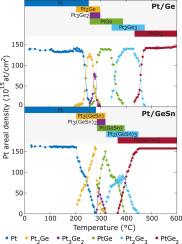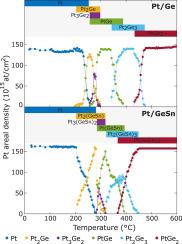Growth and stability of Pt germanides on Ge and GeSn substrates
IF 9.3
1区 材料科学
Q1 MATERIALS SCIENCE, MULTIDISCIPLINARY
引用次数: 0
Abstract
In the pursuit of high-quality contact materials for (opto)electronic devices, replacing Ni with Pt is explored to offer a path towards more stable (stano)germanide contacts. In this study, we resolve the complex sequence of Pt (stano)germanide phase formation through real-time probing of the elemental redistribution using Rutherford backscattering spectrometry, complemented with X-ray diffraction, and the use of artificial neural networks. The existence of the Pt(Ge(Sn)) phase is confirmed, forming simultaneously with PtGe(Sn). Both Pt/Ge and Pt/GeSn systems follow the same phase sequence; however, the Pt/Ge system exhibits superior thermal stability of the monogermanide and the Ge-rich phases throughout an extended temperature range, as well as better morphological stability up to 600 °C, attributed to nucleation-controlled growth of the Ge-rich phases. The metastable incorporation of 7.5% Sn in Ge modifies the thermodynamic and kinetic behavior of Pt stanogermanide formation, as observed by the reduced compositional and morphological stability at elevated temperatures.


锗和锗还原镓基上锗化铟的生长和稳定性
在追求(光电)电子器件的高质量触点材料的过程中,研究人员探索了用Pt代替Ni,以提供一条通向更稳定(stano)锗化物触点的途径。在这项研究中,我们利用卢瑟福后向散射光谱,辅以x射线衍射,并使用人工神经网络,通过实时探测元素重分布,解决了锗化铂(stano)相形成的复杂序列。证实了Pt33(Ge(Sn))22相的存在,并与PtGe(Sn)同时形成。Pt/Ge和Pt/GeSn体系遵循相同的相序;然而,由于富锗相的成核生长,Pt/Ge体系在较宽的温度范围内表现出优异的单锗化物和富锗相的热稳定性,并且在600°C前表现出更好的形态稳定性。7.5% Sn在Ge中的亚稳掺入改变了Pt stanogmanide形成的热力学和动力学行为,在高温下观察到其组成和形态稳定性降低。
本文章由计算机程序翻译,如有差异,请以英文原文为准。
求助全文
约1分钟内获得全文
求助全文
来源期刊

Acta Materialia
工程技术-材料科学:综合
CiteScore
16.10
自引率
8.50%
发文量
801
审稿时长
53 days
期刊介绍:
Acta Materialia serves as a platform for publishing full-length, original papers and commissioned overviews that contribute to a profound understanding of the correlation between the processing, structure, and properties of inorganic materials. The journal seeks papers with high impact potential or those that significantly propel the field forward. The scope includes the atomic and molecular arrangements, chemical and electronic structures, and microstructure of materials, focusing on their mechanical or functional behavior across all length scales, including nanostructures.
 求助内容:
求助内容: 应助结果提醒方式:
应助结果提醒方式:


